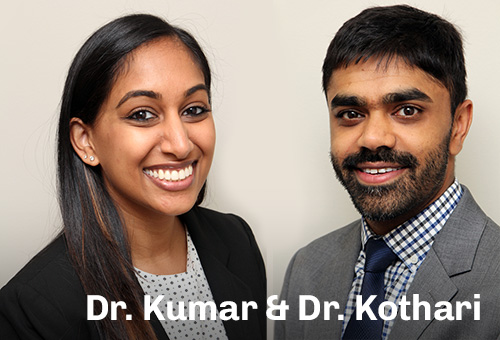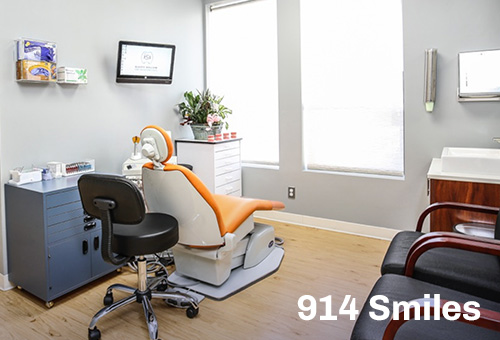
When you open and close your mouth to take a bite of food, speak or yawn, your temporomandibular joints (TMJ) are hard at work. We have a TMJ on either side of our face. The joint, which connects the jaw to the temporal bones in the head, can perform both sliding and hinge motions. The TMJ also has a range of interrelated components like discs, condyles, the facial muscles and cartilage, making it one of the more complex joints. When things are running smoothly, it’s easy to take it for granted. However, when you’re suffering from a temporomandibular joint disorder (TMJD), the result can be pain and a limited range of motion. As a certified specialist in orthodontics, Dr. Kothari doesn’t just straighten teeth; he’s also trained in the growth, development and alignment of the jaw and has a deep understanding of its mechanics. He’s treated many patients with TMJ disorders and the good news is, we can often get amazing results with a conservative approach. Today, we’re covering some of the basics about TMJD and ways you may be able to find relief from TMJ pain.
What is TMD/TMJD?
A temporomandibular joint disorder (TMJD) is a type of temporomandibular disorder (TMD) that can result in pain in the jaw joint and the muscles involved in controlling the movement of the jaw. Sometimes, people use the term TMJ when referring to TMD but TMJ is actually the acronym for the temporomandibular joint itself. We know, there are a whole lot of acronyms involved, which is why it’s easy to see how the terms can be confused. Some of the most common TMD symptoms include:
1. Clicking or popping noises when you open and close your mouth or a grating sensation
2. Tenderness and pain in the jaw, face or around the ear
3. Pain in one or both of the temporomandibular joints
4. Jaw pain that’s more prevalent in the morning or at night
5. Pain in the jaw when yawning, chewing or biting
6. Limited mobility, including difficulty opening the mouth all of the way
7. Jaws that get locked in an open or closed position
8. Muscle spasms in the area of the joints
9. Swelling in the face
10. Pain in the neck, shoulders and, sometimes, even the back
11. Headaches and pain or pressure in the ears or behind the eyes
12. A change in how your upper and lower teeth fit together (i.e., your bite)
13. Sensitive teeth when there are no other dental problems
It’s important to note, however, that while popping and clicking noises in the jaw are TMD symptoms, on their own without pain or limited motion, there’s no evidence they lead to more severe issues and you likely don’t have TMJD and won’t need to seek treatment.
What are the Causes of TMJ Disorders?
TMJ pain can often be temporary and goes away on its own without any intervention. In other cases, unfortunately, TMJ pain is chronic, severe and can interfere with your quality of life. There isn’t one single cause that results in a temporomandibular joint disorder and it can be due to a range of different things. Since TMD symptoms can pop up out of seemingly nowhere, it makes getting to the root of the problem difficult. However, in general, TMJD is thought to be caused by:
1. Chronic teeth grinding, technically called bruxism, which puts pressure on the TMJ and the facial muscles.
2. Stress
3. Jaw injury or dislocation
4. Arthritis, including osteoarthritis and rheumatoid arthritis, in the joint
5. An eroded or misaligned disc
6. An improper bite (how the teeth fit together)
There are also several risk factors that increase the chances of developing TMD, including:
1. Being female, since TMJD affects women almost twice as much as it does men, particularly during the childbearing years and among women who take oral contraceptives or supplemental estrogen. This has led researchers to think female hormones could be tied to TMJD
2. Having a chronic pain disorder or other chronic condition like fibromyalgia or chronic fatigue syndrome, which could indicate similar underlying mechanisms at work
3. Suffering from certain connective tissue disorders
What are My TMD Treatment Options?
Your TMD treatment options will depend on what’s causing it and whether or not the symptoms are interfering with your life. Unless TMJD is debilitating and extremely severe, experts caution against aggressive types of treatment, such as surgery, since there hasn’t been enough research to demonstrate long-term effectiveness. Most people will find relief with a more conservative approach and surgical intervention should always be a last resort. Here are some ways we treat TMJD:
1. Home Remedies: In mild, temporary cases, or even in severe cases while you’re waiting to see a doctor, there are TMJD home remedies that can alleviate discomfort, including resting the joint, taking an over-the-counter, non-steroidal, anti-inflammatory drug like Ibuprofen, applying moist heat to the affected areas, eating soft foods and practicing stress-relief techniques, such as deep breathing.
2. Physical Therapy: If TMD recurs and is bothersome, physical therapy can be really helpful for addressing swelling and pain, boosting your mobility and keeping future attacks at bay. A physical therapist may show you some stretching and strengthening exercises, as well as use moist heat, massage, myofascial release and ultrasound to try to give you relief.
3. Custom Nightguard: Kothari sometimes creates a custom nightguard for patients that prevents them from clenching and grinding in their sleep. It helps to stop compression of the TMJ and prevents further damage by lessening the impact. There are other custom oral appliances too, like splints, that hold the jaw in a stable, comfortable position to take some pressure off the TMJ and decrease pain. Since neither of these create permanent changes in your bite or jaw position, they’re excellent for the first line of treatment and to use while we come up with a long-term plan.
4. Orthodontic Treatment: Kothari may suggest some adjustment, including using braces, Invisalign or certain appliances, to correct both teeth alignment and your bite. If a misaligned jaw was as the root of your problem, this will give you permanent relief. However, he only recommends treatment after a thorough assessment of your bite to ensure the movements he has planned will improve your TMD and not make it worse.
5. Alternative Medicine: Biofeedback or relaxation training may help keep stress under control and allow you to notice when you’re clenching your jaw and learn to release it. Some people also find acupuncture reduces pain and stress levels. Just be sure to find a licensed acupuncturist!
6. Surgery: If nothing else works and your symptoms are severe, chronic and getting in the way of living a normal life, surgery could be an option. There are a number of different types of surgery, including arthroscopic surgery and open-joint surgery. However, as we said, this should always be the last resort and it’s essential you weigh the pros and cons with your surgeon beforehand.
As you can see, overcoming TMJ pain is possible. If you’re experiencing TMJD symptoms, book a free consultation at 914 Orthodontics. Dr. Kothari offers a variety of conservative, effective treatment options for TMJ disorders in Tarrytown. He’ll create a customized treatment plan to help you get relief!



